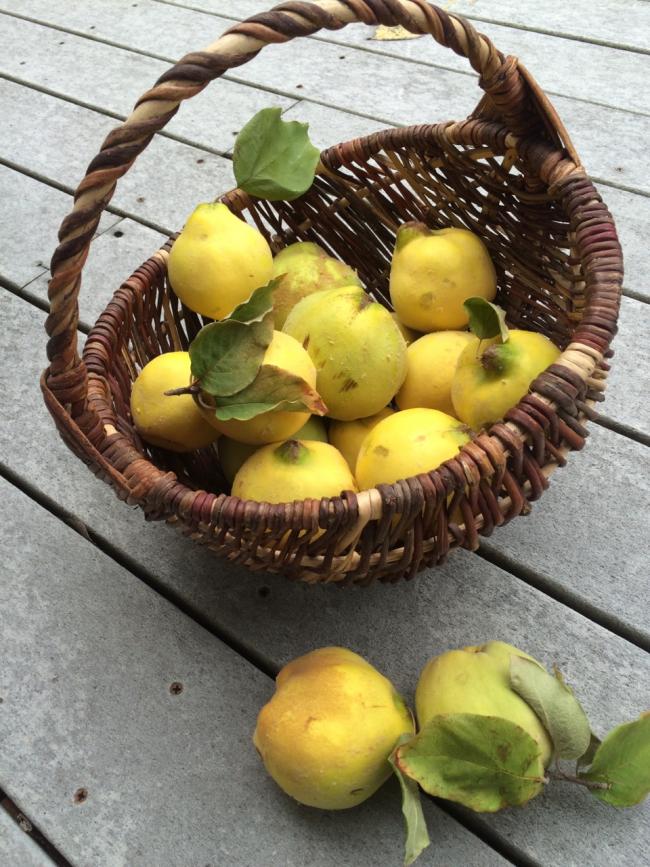You Are What You Eat: Quince, queen of fruits
Though hard to find today, quince trees were a staple in every pioneer garden. Older
Tue, 10/18/2016
By Katy G. Wilkens
I drive by a quince tree on my way to work. One day I am going to stop and say, “Excuse me, I couldn’t help noticing you have ambrosia going to waste in your front yard; can I have your quince?” Quince makes the most wonderful jams, fruit pastes, sorbets, liqueurs and tarts. Poached quince over yogurt is quite possibly the best breakfast you can eat.
Though hard to find today, quince trees were a staple in every pioneer garden. Older homes often have a quince planted years ago by knowing gardeners.
The lovely musky, sweet floral smell of a ripe quince is at odds with the fruit’s lumpy, fuzzy appearance. Fruit should be yellow; let it ripen more if it is green.
Because quince is hard, a cleaver is the best tool I have found to cut the flesh from the core. Some recipes suggest peeling the skin, but that is a hard job; I try to skip it because the peel is full of pectin, which helps when making jam.
Quince will turn brown rapidly when exposed to air. While you are preparing them, drop the slices or grated fruit into water with lemon, vinegar or citric acid (one brand is Fruit-Fresh) to keep them from turning. When quince is heated, enzymes are destroyed and natural tannins are released, creating a beautiful pink that turns darker the longer it cooks. Quince is often paired with star anise, cardamom or ginger.
Quince Jam, Jelly or Spanish Quince Paste
3 pounds of ripe quince
4 1/4 cups water
½ cup lemon juice
7½ cups sugar
¼ teaspoon butter
1 pouch fruit pectin
1 teaspoon ground cardamom or cinnamon, or 2 star anise or slices of fresh ginger
Wash fruit and then slice wedges off around core, being careful of your fingers. Or grate the fruit around the core. Simmer quince, sugar and spices in water at low heat until fork tender.
Mash the fruit with a potato masher if you want jam; strain the fruit if you want jelly. Keep the extra fruit and serve over yogurt, ice cream or add to apple pie. Continue with 4 cups of mashed fruit or liquid.
Add lemon juice to the 4 cups and heat, then add butter to keep from foaming. When the mixture boils, add pectin. Bring to a boil again for one minute. Remove from heat, skim off any foam and then pour into clean jars or freezer containers. You may can jars of jam or jelly using a hot water bath at this point, or freeze containers.
If you like membrillo, a Spanish quince paste served with cheese, pour jam in shallow trays and put in a dehydrator overnight. You can also dehydrate membrillo in an oven on low heat. It takes hours that way, but your house will smell wonderful!
Quince Sorbet
3-4 medium size quinces
½ cup sugar
¼ cup honey
3 cups water
4 cardamom pods or 2 star anise or 2 ginger coins
1 teaspoon vanilla
Peel and core quince and then cut into wedges. Place quince in a large pot and add sugar, honey, spices, vanilla and water. Cover and simmer about an hour until fruit is fork tender and pink. Reserve about ½ cup syrup and fruit for other recipes, or serve over sorbet.
Process the rest of the fruit and syrup in food processor. Put in ice cream maker or a shallow baking tray in freezer. If you are using the tray method, stir with a fork every 30 minutes or so for about two hours. When done, cover and keep up to two weeks in freezer.
Nutrition information
Jelly/Jam (1 tablespoon): Calories: 25, carbohydrates: 7 g, protein: 0 g, sodium: 1 mg
Sorbet (1/2 cup): Calories: 77, carbohydrates: 20 g, protein: 0 g, sodium: 4 mg
The information in this column is meant for people who want to keep their kidneys healthy and blood pressure down by following a low-sodium diet. In most cases, except for dialysis patients, a diet high in potassium is thought to help lower high blood pressure. These recipes are not intended for people on dialysis without the supervision of a registered dietitian.
Katy G. Wilkens is a registered dietitian and department head at Northwest Kidney Centers. A recipient of the Susan Knapp Excellence in Education Award from the National Kidney Foundation Council on Renal Nutrition, she has a Master of Science degree in nutritional sciences from the University of Washington. See more of her recipes at www.nwkidney.org.


